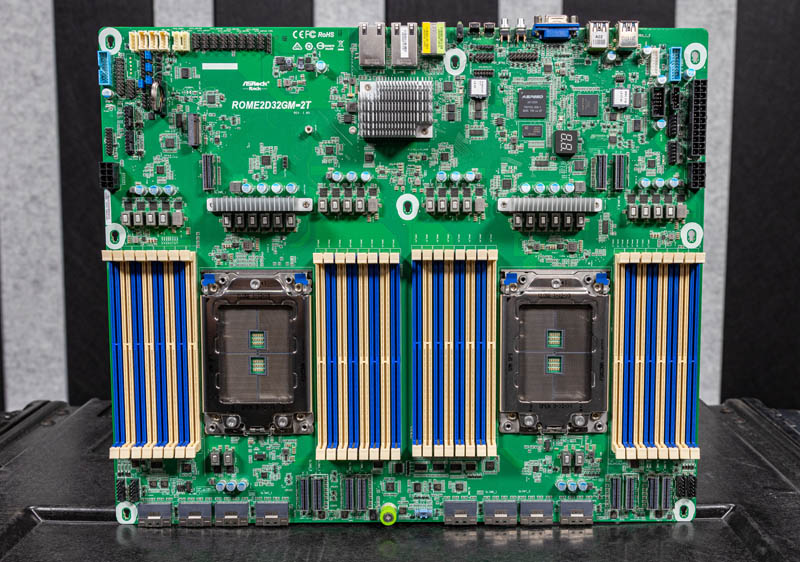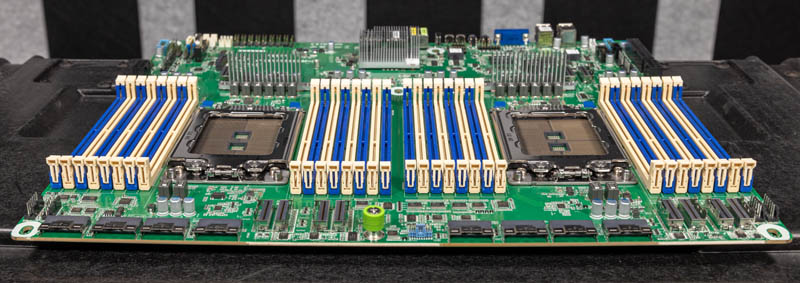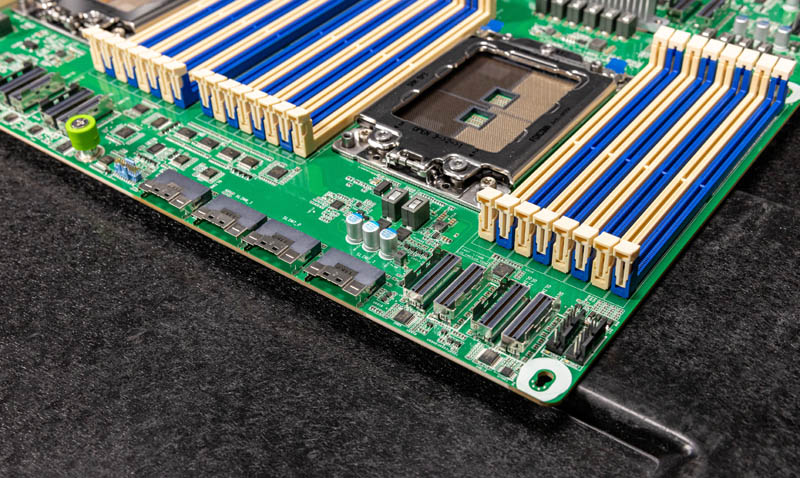The ASRock Rack ROME2D32GM-2T is certainly a large motherboard. This motherboard is a proprietary size at 16.53″ x 14.56″, but also has some cool features. Namely, it can support up to 32x SATA III devices as well as dual AMD EPYC 7002/ 7003 processors and a full set of 32x DIMMs.
ASRock Rack ROME2D32GM-2T Overview
Let us get this out of the way first. This motherboard is big at 16.53″ x 14.56″. What is very interesting about this motherboard though is that it has features we see in two different classes of motherboards. First, it is wide, like a proprietary motherboard to fit all of the functionality of the platform. Second, it also has standard power connectors instead of having direct PSU to motherboard connectivity.

The big thing that this motherboard design gives us though is a proper dual AMD EPYC setup. We get two CPUs with a total of 16x DDR4 DIMMs per for 32x DIMM slots total. Many smaller EATX motherboards cannot handle this many DIMMs. This is a PCIe Gen4 motherboard, so it is designed for AMD EPYC 7003 “Milan” and EPYC 7002 “Rome” generation CPUs.

The other main benefit to this design is that it allows proper airflow through the CPU heatsinks. That allows one to use up to 280W TDP CPUs in this platform.
Something our readers have probably noticed at this point is that this motherboard is the first we have reviewed without a single standard PCIe slot or a standard SATA port. Instead, this platform primarily uses SlimSAS connectors to handle PCIe Gen4 and SATA devices.

On the front edge of the motherboard, there are a total of 16x SlimSAS connectors that allow for up to 128 lanes of PCIe Gen4 and up to 32x of those lanes to be SATA instead. Here is a few of the left edge with four SlimSAS x8 connectors that are parallel to the motherboard and four that are vertical.

On the other side we have another eight ports with four horizontal and four vertical.

That is not all the I/O on this platform either. We also have a M.2 PCIe Gen4 x8 slot and another SlimSAS low profile slot.

One item that needs to be pointed out is that there are also provisions for this to be a storage server platform even without PCIe slots and SATA ports. We still get SGPIO ports on the edge of the motherboard.

On the other side, we have the ASPEED AST2500 BMC. One can see that there is a lot more going on here. There is a POST code LCD display. We also get another two SlimSAS ports. Finally, on the very right, we get the power inputs (one other CPU power input is on the opposite side) as well as a USB 3.0 front panel connector.

Something you may be noticing is that the motherboard’s holes are designed to mount to notched pegs instead of a standard screw mounting. This is designed to be a tool-less installation and locked in place via the large green thumbscrew above.
For those counting, we get a total of 19x SlimSAS connectors on this motherboard for a total of 152x lanes of I/O. We also get the x4 M.2 slot for 156 of the possible 160 lanes without any of the other devices in the system being accounted for.

The rear I/O panel is designed for a proprietary server. We get two sets of two USB 3.0 ports, a VGA port, and even power/ reset buttons. On the right side we have a RJ45 out-of-band management port and two network ports.

The two network ports utilize an Intel X550-at2 NIC that is below this large heatsink. This large heatsink allows cooling the higher power 10GbE standard.

This is a bit different than the normal reviews that we do. It is still very cool. This is a very modern motherboard design from ASRock Rack.
Next, we are going to take a look at how this is all hooked up given the block diagram. We are also going to discuss management.





This is brilliant. This shows what can be done if we will just break our addiction to PCIe slots.
Thanks to Eric for featuring it.
Imagine the same apporoach taken to a UP Epyc or a TR Pro board: you could have a row of slim sas connectors lined up beside the CPU, providing a dozen PCIe4 x8 links. Short traces lower the cost of manufacturing it. Such a board could be uATX in size but have the IO of a EATX.
There are 4 USB3 ports on the edge of the motherboard, not 2 as stated in the article.
That is different. Not locking you into specific psus
@emerth nailed it on the head- this is why STH is the only site I read the comments.
The way the review was stated, it sounds like this was a showcase piece for Asrock Rack. I’ll be curious if there is a vendor lined up already to integrate this, or maybe someone will build a modular platform around it.
I want to see this in a chassis, but I mean I love that STH does these reviews with all of that “STH context”. It’s so cool that there’s a site that can explain why not just what.